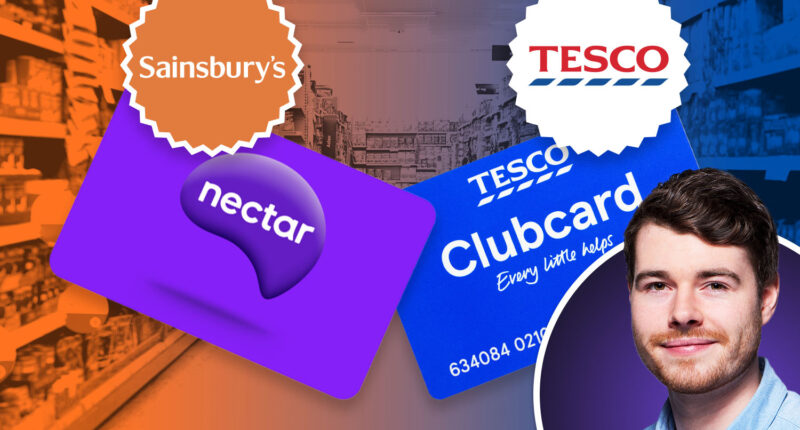SHOPPERS battling high food costs have been handed price cuts by many supermarkets – but only if they are members of loyalty schemes.
Tesco was the first supermarket to offer Clubcard holders exclusive prices back in 2019.
Sainsbury’s followed suit earlier this year when it launched its Nectar Prices scheme.
Anyone shopping at both these supermarkets faces paying more for thousands of items if they don’t have a Clubcard or Nectar card.
I put these two loyalty scheme incentives to the test to see exactly how much you could be missing out on.
Tesco Clubcard shoppers are promised 8,000 exclusive discounts online and in stores on everything from fresh food to homeware with the Clubcard, which is free to join.
The cheaper prices are automatically applied to bills when shoppers scan their Clubcard at the checkout.
At Sainsbury’s, Nectar Prices work in a similar way. You’ll need to sign up for the free Nectar card and scan it at the tills to get the discounts.
Both shops promote cheaper prices for members of their loyalty schemes on the shelves too.
I took a shopping list of 25 everyday essentials to both supermarkets to see how much they could save you – and if they are really good value for money.
Most read in Money
How much can you save on the average shop?
I bought everything that you’d usually expect to find in a weekly shop, ranging from milk, eggs and bread, to meat and veg, as well as some sweet treats.
I picked like-for-like products from both supermarkets and compared the total cost.
Where there was no member price for an item, I opted for the most bought in each category.
For example neither supermarket had member prices on grapes, so I added their standard own-brand items to my basket instead.
Some of the items without member prices fell under a different promotion, however, where both supermarkets’ price match Aldi.
I would have paid £70.72 for all my 25 items without Tesco Clubcard.
With a handy swipe of the card at the till, the bill quickly reduces to just £56.44.
That’s a saving of £14.28 – a decent discount for any savvy shopper – and it can quickly add up.
Over a year this would work out as £744.60.
At Sainsbury’s I added the same range of items to my trolley and made my way to the tills.
My weekly shop added up to £73.57 – slightly more than at Tesco.
But with just a scan of my handy Nectar card, the bill instantly fell to just £57.87.
I saved £15.70 on my basket of groceries, adding up to £818.64 a year.
Compared to Tesco, the saving at Sainsbury’s was £1.42 a week more, or £74.04 over a year.
Without the member prices, I’d pay £2.85 more per week at Sainsbury’s than at Tesco.
It’s a no-brainer to sign up for both of these schemes if you shop at either supermarket chain to avoid paying more than you need to.
Are member prices worth it?
When comparing these prices, I was struck by several ways shoppers might be dazzled by these discounts and end up spending more than they need to – despite the apparent savings.
The majority of member prices I found were on branded items.
Certain necessities like bread, eggs, fruit and veg don’t have their prices marked down for loyalty card holders.
Instead, some are price-matched to Aldi and in some cases are the cheapest available.
But I found dozens of items from both supermarkets that were far cheaper than member prices.
Shoppers at Tesco could cut their bill to just £39.63 a week, or £36.55 a week at Sainsbury’s, by avoiding member prices altogether.
This means that if a Tesco Clubcard shopper was to swap out the 25 items with member prices on our list for their closest own-label equivalents, they’d save even more – £16.83 or £877.57 a year.
It’s the same at Sainsbury’s where a shopper opting for the closest cheapest own-label alternative could cut their bill by £21.32 a week or a whopping £1,111.69 a year.
Member prices, other deals and standard prices themselves can change from one day to the next, so it’s worth remembering that this is just a snapshot at the time and exact savings can vary.
I looked at the cheapest available own-label item at each supermarket, with some slight variation in size and quantity, to compare them to member prices.
For example, Tesco’s cheapest own-label cheddar is smaller at 220g, than Cathedral City’s 350g block of cheese, and 45p cheaper.
But own-label Sainsbury’s Hubbard’s Foodstore spaghetti is larger at 1kg than Napolina’s 500g pack, and is less than half the price.
It highlights the difficulty many shoppers face when trying to compare items.
Are you getting the best deal?
Unit prices are meant to make it easier for shoppers to compare similar items of different sizes.
It works by reducing the item to a cost per 100ml for cans of coke for example, so you can then see the lowest unit cost.
All shops are obligated to show unit pricing, under legislation known as the Price Marking Order 2004.
You should be able to see the unit price of the product where its price tag is shown.
These are in the small print of shelf labels, but can be hard for many shoppers to find.
Research by Which? found that 72% of people could not work out the cheapest item when comparing products in store.
Shoppers will also find it impossible to compare unit prices on any items in Tesco that have Clubcard Prices.
That’s because the supermarket doesn’t display them on this promotion – something consumer experts at Which? claim is misleading shoppers.
Tesco says it complies with all the rules and has had approval from trading standards that it meets legal requirements and guidelines.
It’s better news for shoppers at Sainsbury’s though.
The supermarket told The Sun that unit prices for items discounted under the Nectar Prices promotion are visible on shelf edge labels in its supermarkets, as well as when logged in on its website.
Paying close attention to the unit prices of the staples in your shopping trolley can help you better compare prices and save money.
And just because something has a members-only price tag doesn’t mean that it’s the bargain it first appears.
Sue Davies, Which? head of food policy said: “With food prices continuing to rise – many of us are looking to save where we can.
“If you regularly use the same supermarket for your weekly shop then research shows you could make significant savings by signing up to their loyalty scheme.
“To maximise the benefits of having a loyalty card, shoppers should always check whether the loyalty card price is really the best value.
“Unfortunately, loyalty card offers don’t always show the unit price so it can be difficult to compare different sizes and brands.”
What do the supermarkets say?
A Tesco spokesperson said: “With household budgets under continued pressure, we remain absolutely focused on providing great value for our customers.
“Our market-leading combination of Clubcard Prices, Aldi Price Match and price-locking 1,000 products with Low Everyday Prices means we are the most competitive we have ever been.”


A Sainsbury’s spokesperson said: “We re-branded our own brand value products under the Stamford Street range to help our customers more easily find our lowest cost products in-store and online.
“We offer a wide range of products to give our customers the choice while still saving money with our Aldi Price Match campaign, Stamford Street range and through Nectar Prices.”












